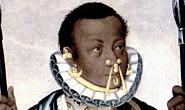 |
||||||||||||||||||||
 |
||||||||||||||||||||
 |
||||||||||||||||||||
|
Analyzing Documents presents case studies that show how scholars interpret different kinds of historical evidence in world history. Here are two paintings from 16th-century Spanish America: a map from the Codex Mendoza (circa 1543) that represents the founding of Tenochtitlan, the large imperial capital of the Aztecs, and a painting entitled “The Mulatto Gentlemen of Esmeraldas” by Andrés Sánchez Gallque (1599). These images offer an important window into visual culture and social, religious, and political life in the early era of Spanish colonization. The two paintings were commissioned, in different times and places, as gifts to the King of Spain. Their similarities and differences illustrate both cultural change and cultural resilience. Look at these images carefully.
Now see how Art Historian Dana Leibsohn interprets these two images.
|
||||||||||||||||||||||||||||||||||||||||||||||||||||||||||||||
|
finding world history | unpacking evidence | analyzing documents | teaching sources | about |
|


